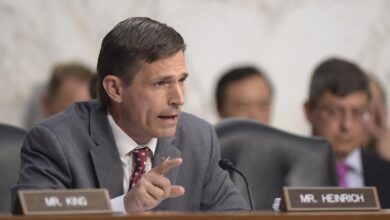
Examining Claims of Socialism in Obama and Biden Policies
Examining claims of socialism in Obama and Biden policies, a topic that has ignited heated debate and fueled political polarization, invites us to delve into the complex interplay between historical context, policy implementation, and public perception. This exploration will navigate the shifting sands of the term “socialism” in American politics, analyzing specific policies and their alleged socialist leanings, and ultimately, assess the extent to which these administrations embraced socialist principles.
From the Affordable Care Act to the American Recovery and Reinvestment Act, certain policies implemented during the Obama and Biden administrations have been labeled as socialist. This begs the question: Do these policies truly align with socialist principles, or are they merely progressive interventions aimed at addressing social and economic inequalities?
This analysis will examine the arguments presented by both proponents and critics, dissecting the justifications and evidence behind each perspective.
Historical Context
The concept of socialism in the United States has a long and complex history, marked by evolving interpretations and political uses. From its early association with utopian communities to its association with the Cold War and the rise of the New Left, the term “socialism” has been imbued with different meanings and connotations throughout American history.
Understanding this historical context is crucial for comprehending the current political landscape and the ongoing debates surrounding the role of government in society.
Early Interpretations and Utopian Communities
Early American socialists, inspired by the writings of Karl Marx and other European thinkers, envisioned a society based on cooperation and social justice. They believed in the abolition of private property and the establishment of a more equitable distribution of wealth.
However, these early socialist movements often remained confined to small, utopian communities, such as the Brook Farm in Massachusetts and the New Harmony in Indiana. These communities, while demonstrating the ideals of socialism, failed to achieve widespread success or lasting impact on the larger society.
The Rise of Labor Unions and the Progressive Era
The late 19th and early 20th centuries witnessed the rise of labor unions and the emergence of the Progressive movement. Labor unions advocated for workers’ rights and pushed for government intervention in the economy to protect workers from exploitation. The Progressive movement, which sought to address social ills and promote social justice, also embraced some socialist ideas, such as government regulation of corporations and the expansion of social welfare programs.
This period saw the passage of significant legislation, including the Sherman Antitrust Act and the Pure Food and Drug Act, which reflected a growing acceptance of government intervention in the economy.
The Cold War and the Red Scare
The Cold War era, characterized by intense ideological rivalry between the United States and the Soviet Union, had a profound impact on the perception of socialism in America. The term “socialism” became synonymous with communism, and the fear of communist infiltration and subversion led to a period of intense anti-communist paranoia known as the Red Scare.
This era saw the persecution of suspected communists and the suppression of dissenting voices, creating a climate of fear and suspicion around any association with socialist ideas.
Examining claims of socialism in Obama and Biden policies can be a complex undertaking, often leading to heated debates. It’s easy to get caught up in the political rhetoric and lose sight of the bigger picture. Sometimes, it feels like navigating a complex online learning platform – full of glitches and unexpected hurdles, but with occasional glimpses of genuine learning and fun.
Disappointing grades, technology glitches, and glimpses of learning fun are all part of the experience, just like the ups and downs of political discourse. Ultimately, understanding these policies requires a willingness to engage with diverse perspectives and to sift through the noise to find the truth.
The New Left and the Rise of Social Movements
The 1960s witnessed the rise of the New Left, a social movement that sought to challenge the status quo and advocate for social justice, civil rights, and an end to the Vietnam War. While not explicitly socialist, the New Left drew inspiration from socialist ideas and principles, particularly in its emphasis on grassroots activism, community organizing, and the critique of capitalism.
This era saw the emergence of various social movements, such as the Civil Rights Movement, the anti-war movement, and the women’s liberation movement, which challenged traditional power structures and advocated for greater social equality.
The Evolution of the Term “Socialism”
The term “socialism” has undergone a significant evolution in American politics. Initially associated with radical utopian communities and later linked to the threat of communism during the Cold War, the term has been used to describe a wide range of political ideologies and policy proposals.
Examining claims of socialism in Obama and Biden policies is a complex issue, often clouded by partisan rhetoric. It’s like trying to find the perfect pasta bowl – you want something that’s functional, stylish, and can hold more than just pasta.
The best pasta bowls work for more than just pasta , and the same goes for policy analysis. We need to look beyond labels and examine the actual effects of policies on people’s lives, regardless of who implemented them.
In recent years, the term “socialism” has been increasingly adopted by progressive activists and politicians to describe a vision of a more equitable and just society. However, the meaning of “socialism” remains contested, with different interpretations and political agendas.
Key Policy Areas
This section delves into specific policies implemented during the Obama and Biden administrations that have been labeled as socialist, examining the arguments for and against this categorization. It aims to provide a nuanced understanding of these policies and their potential alignment with socialist principles.
The Affordable Care Act (ACA)
The Affordable Care Act (ACA), also known as Obamacare, is one of the most significant pieces of legislation passed during the Obama administration. It aimed to expand health insurance coverage to millions of Americans through a combination of individual and employer mandates, subsidies, and market reforms.
Critics argue that the ACA embodies socialist principles by expanding government involvement in healthcare and creating a system where the government plays a significant role in providing and regulating healthcare services. They point to the individual mandate, which requires individuals to purchase health insurance or face a penalty, as a form of government coercion and interference in personal choices.
Additionally, they argue that the ACA’s expansion of Medicaid, a government-funded health insurance program for low-income individuals, represents a significant expansion of government spending and social welfare programs, a hallmark of socialist ideology.
“The ACA is a prime example of a socialist policy that aims to create a universal healthcare system through government intervention and control.”
Conversely, proponents of the ACA argue that it is not socialist but rather a pragmatic approach to addressing the issue of rising healthcare costs and lack of insurance coverage. They emphasize that the ACA is a market-based solution that utilizes private insurance companies and encourages competition.
They also argue that the individual mandate is necessary to ensure a healthy insurance pool and prevent adverse selection, where only the sickest individuals purchase insurance. Additionally, they point to the fact that the ACA has led to a significant decrease in the number of uninsured Americans and has provided millions with access to affordable healthcare.
“The ACA is a market-based solution that utilizes private insurance companies and encourages competition. It is not a socialist policy.”
Stimulus Packages and Economic Recovery
In response to the Great Recession, the Obama administration implemented several stimulus packages aimed at stimulating the economy and creating jobs. These packages included significant government spending on infrastructure projects, tax cuts for businesses and individuals, and assistance to struggling industries.
Critics argue that these stimulus packages represent a socialist approach to economic management, where the government intervenes heavily in the economy through spending and regulation. They argue that such interventions distort market signals, discourage private investment, and ultimately lead to economic inefficiency.
“The Obama administration’s stimulus packages represent a socialist approach to economic management, where the government intervenes heavily in the economy through spending and regulation.”
Supporters of the stimulus packages argue that they were necessary to prevent a deeper economic downturn and to accelerate the recovery process. They point to the fact that the economy did eventually recover and that unemployment rates declined significantly after the implementation of these packages.
They also argue that government spending on infrastructure projects created jobs and stimulated economic activity, while tax cuts for businesses and individuals provided much-needed relief and encouraged investment.
“The stimulus packages were necessary to prevent a deeper economic downturn and to accelerate the recovery process. They were not socialist policies but rather pragmatic measures to address a crisis.”
Economic Policies: Examining Claims Of Socialism In Obama And Biden Policies
The economic policies of the Obama and Biden administrations have been marked by a significant role for government intervention and social welfare programs. Both presidents have sought to address economic challenges, including the Great Recession, the COVID-19 pandemic, and rising income inequality, through a combination of regulatory measures, fiscal policies, and social safety net programs.
This section will delve into the specifics of their economic policies, examining their approaches to regulation, taxation, and social spending, and evaluating the extent to which these policies reflect socialist principles.
Regulation
The Obama and Biden administrations have pursued different approaches to economic regulation. While both presidents have favored some level of government oversight, their specific policies have varied in their scope and intensity. The Obama administration, in response to the financial crisis of 2008, implemented a series of regulations aimed at strengthening the financial system, including the Dodd-Frank Wall Street Reform and Consumer Protection Act.
This legislation sought to prevent future financial crises by increasing transparency, oversight, and accountability within the financial sector. The Biden administration has continued to build on this foundation, enacting additional regulations to address concerns about climate change, consumer protection, and corporate behavior.
The Biden administration has also sought to increase the role of the government in the economy through a series of infrastructure investments, such as the Bipartisan Infrastructure Law, which aims to modernize roads, bridges, airports, and other infrastructure projects. This approach aligns with a broader trend toward increased government spending on infrastructure and social programs, which some argue is a hallmark of socialist policies.
Social Policies
The social policies implemented during the Obama and Biden administrations represent a significant departure from the preceding decades, particularly in areas like healthcare, education, and social justice. These policies, often characterized as progressive, aim to address long-standing societal inequities and expand access to essential services.
While the extent to which these policies align with socialist principles is a subject of debate, they undeniably reflect a commitment to government intervention and social welfare.
Healthcare
The Affordable Care Act (ACA), enacted during the Obama administration, marked a significant shift in American healthcare policy. The ACA aimed to expand health insurance coverage to millions of Americans through a combination of individual mandates, subsidies, and market reforms.
The law also introduced provisions to address pre-existing conditions and expand access to preventive care. The ACA’s impact on healthcare access and affordability has been substantial. According to the Kaiser Family Foundation, the uninsured rate among adults aged 18-64 declined from 20.3% in 2010 to 10.9% in 2016.
The law has also led to a decrease in the number of Americans with medical debt.While the ACA has been lauded for its positive impact on healthcare access, it has also faced criticism. Critics argue that the law has led to higher healthcare costs and increased government spending.
They also point to the law’s complex structure and its reliance on market mechanisms, which they argue have not adequately addressed the issue of rising healthcare costs.
Examining claims of socialism in Obama and Biden policies often leads to heated debates, but it’s important to remember that even the most impactful policies can have unintended consequences. A great example of this is how short-term policies can have lasting impacts, as seen in the analysis of the long-lasting legacy of a short-term prime minister.
This type of analysis can help us better understand the potential long-term ramifications of any policy, even those aimed at addressing immediate needs.
Education
The Obama administration focused on improving educational outcomes through initiatives like the Race to the Top program, which provided grants to states that implemented reforms aimed at improving student achievement. The administration also expanded access to early childhood education and increased funding for Pell Grants, which help low-income students afford college.The Biden administration has continued to prioritize education reform, focusing on issues like early childhood education, college affordability, and teacher training.
The administration has also proposed policies to address the racial achievement gap and provide greater support for students with disabilities.The impact of these policies on educational attainment is a complex issue. While some studies have shown positive effects, others have found mixed results.
For example, a 2018 study by the National Center for Education Statistics found that the high school graduation rate increased from 80.7% in 2011 to 84.9% in 2017. However, the study also found that the achievement gap between white students and students of color persisted.
Social Justice
The Obama and Biden administrations have prioritized social justice issues, addressing systemic inequities in areas like criminal justice, immigration, and LGBTQ+ rights. The Obama administration signed into law the Fair Sentencing Act, which reduced the disparity in sentencing between crack cocaine and powder cocaine offenses, and implemented policies to address racial bias in the criminal justice system.
The administration also took steps to protect the rights of LGBTQ+ individuals, including issuing an executive order prohibiting discrimination based on sexual orientation and gender identity in federal employment.The Biden administration has continued to advance social justice initiatives, focusing on issues like racial equity, immigration reform, and climate change.
The administration has also taken steps to address the economic disparities that disproportionately affect communities of color.The impact of these policies on social outcomes is a subject of ongoing debate. Some argue that these policies have led to significant progress in addressing social inequities, while others contend that they have had a limited impact or have even exacerbated existing problems.
International Relations

The international relations of the Obama and Biden administrations were marked by a strong emphasis on diplomacy and multilateralism, with a focus on promoting global cooperation and addressing global challenges. Both administrations sought to build and strengthen international institutions and partnerships, utilizing foreign aid as a tool for development and security.
However, they also faced criticism for their use of military intervention in certain instances.
International Trade
The Obama and Biden administrations pursued a mixed approach to international trade, balancing the benefits of free trade with the need to protect domestic industries and workers. While both administrations supported the World Trade Organization (WTO) and other multilateral trade agreements, they also utilized trade sanctions and other measures to address unfair trade practices and protect American interests.
The Obama administration signed the Trans-Pacific Partnership (TPP) trade agreement, a controversial deal that aimed to lower trade barriers and promote economic growth among 12 Pacific Rim countries. However, the agreement was ultimately rejected by the U.S. Congress and never went into effect.
The Biden administration has taken a more cautious approach to trade, emphasizing the importance of “fair trade” and seeking to renegotiate existing trade agreements to address labor and environmental concerns. The administration has also been critical of China’s trade practices and has implemented tariffs on Chinese goods.
Foreign Aid, Examining claims of socialism in obama and biden policies
The Obama and Biden administrations have viewed foreign aid as a critical tool for promoting development, security, and stability around the world. Both administrations have significantly increased funding for foreign aid, particularly for programs focused on health, education, and democracy promotion.
The Obama administration’s “Quadrennial Diplomacy and Development Review” (QDDR) emphasized the importance of integrating diplomacy and development, arguing that foreign aid could be used to advance U.S. foreign policy goals. The Biden administration has continued this approach, with a particular focus on promoting gender equality and climate change mitigation.
Military Intervention
While both Obama and Biden administrations prioritized diplomacy and multilateralism, they also engaged in military intervention in certain situations. The Obama administration authorized the use of military force in Libya, Syria, and Yemen, while the Biden administration has continued to use military force in Afghanistan and Iraq.The use of military force has been a source of controversy, with critics arguing that it undermines the principles of diplomacy and multilateralism.
Supporters of military intervention argue that it is sometimes necessary to protect U.S. interests and advance global security.
Impact on Global Relations
The foreign policy approaches of the Obama and Biden administrations have had a significant impact on global relations. Their emphasis on diplomacy and multilateralism has contributed to the strengthening of international institutions, such as the United Nations and the WTO.
Both administrations have also played a key role in addressing global challenges, such as climate change, pandemics, and nuclear proliferation. However, their use of military intervention has also been a source of tension and conflict, particularly in the Middle East.The impact of their policies on global development is mixed.
While their increased foreign aid funding has supported development programs around the world, their trade policies have also had a negative impact on developing countries.
Political Rhetoric and Public Perception
The term “socialism” has been a potent political weapon in American discourse, particularly in the context of policies proposed by Barack Obama and Joe Biden. This section examines how the label “socialism” has been used both as a rallying cry and a smear tactic, and analyzes its impact on public perception and the political landscape.
The Use of “Socialism” as a Political Tool
The use of “socialism” as a political tool has a long history in the United States, often employed to discredit policies perceived as expanding government intervention in the economy or social life. This tactic intensified during the Obama and Biden administrations, with Republicans and conservative media outlets frequently labeling their policies as “socialist.” The term “socialism” was often used to attack policies such as the Affordable Care Act (ACA), which aimed to expand health insurance coverage through government-regulated marketplaces.
Critics argued that the ACA was a step towards a “socialist” healthcare system, while supporters countered that it was a necessary reform to address market failures in the healthcare industry.Similarly, the American Recovery and Reinvestment Act of 2009, a stimulus package enacted in response to the Great Recession, was frequently criticized as a “socialist” measure.
Critics argued that the government’s intervention in the economy was excessive and would lead to increased government control. Supporters countered that the stimulus was necessary to prevent a deeper economic downturn and create jobs.
The Impact of “Socialism” Rhetoric on Public Perception
The use of “socialism” as a political weapon has had a significant impact on public perception of Obama and Biden policies. Polls consistently show that Americans have a negative view of socialism, and this perception has influenced how they view policies associated with the term.
“Socialism is a dangerous and discredited ideology that has no place in America.”
A common refrain from Republican politicians and conservative media outlets.
The use of “socialism” as a smear tactic has also contributed to the polarization of American politics. By labeling their opponents as “socialists,” Republicans have been able to mobilize their base and create a sense of fear and distrust towards Democratic policies.
This polarization has made it more difficult to find common ground and compromise on issues of national importance.
Comparing and Contrasting
Both the Obama and Biden administrations implemented policies that addressed a wide range of social and economic issues. While they shared some common goals, their approaches and the specific policies they enacted differed in certain aspects. This section explores the similarities and differences between their policies, examining the extent to which both administrations embraced socialist principles.
Similarities in Policy Approaches
Both Obama and Biden came to power during periods of economic crisis, and their policies reflected a focus on government intervention to stimulate economic growth and provide social safety nets. They both expanded government programs, particularly in healthcare and social welfare.
- Expansion of Healthcare Coverage:The Affordable Care Act (ACA), enacted during the Obama administration, aimed to expand healthcare coverage to millions of Americans through a combination of subsidies, mandates, and market reforms. The Biden administration continued to build on the ACA, enacting further expansions and protections for pre-existing conditions.
- Social Welfare Programs:Both administrations expanded social welfare programs, such as food stamps, unemployment benefits, and tax credits for low-income families. These programs aimed to provide financial assistance and support to vulnerable populations.
- Stimulus Packages:Both administrations enacted large-scale stimulus packages in response to economic crises. These packages included investments in infrastructure, tax cuts, and direct payments to individuals and businesses. The goal was to stimulate economic activity and create jobs.
Differences in Policy Approaches
Despite their shared commitment to government intervention, the Obama and Biden administrations differed in their approaches to certain policy areas.
- Regulation:The Obama administration emphasized stricter regulations on businesses, particularly in the financial sector, to prevent future crises. The Biden administration has also focused on regulation, but with a broader emphasis on environmental protection and consumer safety.
- Tax Policy:While both administrations supported tax cuts for certain groups, their approaches differed. Obama’s tax cuts were primarily aimed at middle-class families, while Biden’s tax cuts have focused on incentivizing green energy and clean technologies.
- Foreign Policy:Obama’s foreign policy emphasized diplomacy and multilateralism, while Biden has taken a more assertive approach, particularly towards China and Russia.
Socialist Principles in Obama and Biden Policies
The extent to which both administrations embraced socialist principles is a matter of debate. Some argue that their policies, particularly in areas like healthcare and social welfare, reflect a shift towards a more social democratic model.
- Government Intervention:Both administrations embraced government intervention in the economy, a core principle of socialism. This included regulating industries, providing social safety nets, and investing in public services.
- Social Welfare Programs:The expansion of social welfare programs, such as Medicare and Medicaid, aligns with socialist ideals of social justice and ensuring a basic standard of living for all citizens.
- Economic Equality:While neither administration explicitly advocated for economic equality, their policies aimed to reduce income inequality and provide opportunities for upward mobility. This aligns with socialist principles of social justice and economic fairness.
Implications for Understanding Socialist Ideas in American Politics
The policies of Obama and Biden demonstrate the evolution of socialist ideas in American politics. While both administrations have embraced some socialist principles, they have done so within a framework of democratic capitalism.
- Shifting Public Opinion:The growing acceptance of government intervention in the economy and social welfare programs suggests a shift in public opinion towards more socialist ideas.
- Evolving Political Landscape:The rise of progressive movements and the growing popularity of democratic socialist candidates indicate that socialist ideas are becoming more mainstream in American politics.
- Future of American Politics:The policies of Obama and Biden provide a glimpse into the potential future of American politics, where socialist ideas may play a more prominent role in shaping policy debates and influencing public opinion.
Final Summary
In conclusion, examining claims of socialism in Obama and Biden policies reveals a nuanced and multifaceted landscape. While certain policies may share some commonalities with socialist ideals, they are ultimately rooted in a broader context of addressing contemporary social and economic challenges.
The debate surrounding “socialism” in American politics is a complex one, shaped by historical baggage, ideological differences, and shifting public perceptions. Ultimately, this analysis underscores the importance of critically evaluating the rhetoric surrounding these policies and engaging in informed discussions about the role of government in a democratic society.






